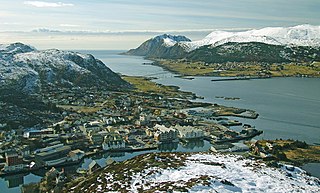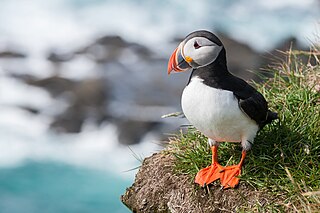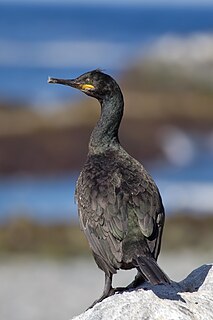| Runde Ramsar Site | |
|---|---|
| Nearest city | Runde |
| Coordinates | 62°23′00″N5°37′00″E / 62.38333°N 5.61667°E Coordinates: 62°23′00″N5°37′00″E / 62.38333°N 5.61667°E |
| Area | 350 ha (860 acres) |
| Established | 2013 |
| Official name | Runde |
| Designated | 27 May 2013 |
| Reference no. | 2164 [1] |
The Runde Ramsar Site is a Ramsar Convention area consisting of five previously approved protected areas in the municipalities of Herøy and Ulstein in Møre og Romsdal county, Norway. The area was established in 2013. [2]

The Ramsar Convention on Wetlands of International Importance especially as Waterfowl Habitat is an international treaty for the conservation and sustainable use of wetlands. It is also known as the Convention on Wetlands. It is named after the city of Ramsar in Iran, where the Convention was signed in 1971.

Herøy is a municipality in Møre og Romsdal county, Norway. It is part of the Sunnmøre region. The administrative centre is the town of Fosnavåg on the island of Bergsøya. The industrial area of Eggesbønes is located south of Fosnavåg on the same island. The Runde Environmental Centre is located in the northern part of the municipality on Runde island. Other population centres in Herøy include the villages of Leikong, Kvalsund, or Moltustranda.

Ulstein is a municipality in Møre og Romsdal county, Norway. It is part of the Sunnmøre region. The commercial and administrative centre of Ulstein is the town of Ulsteinvik. The municipality occupies the western half of the island of Hareidlandet, as well as about 30 smaller islands, four of which are populated.
The five protected areas consist of four bird sanctuaries and one nature reserve, all of which are connected to the bird cliff island of Runde.

A bird reserve is a wildlife refuge designed to protect bird species. Like other wildlife refuges, the main goal of a reserve is to prevent species from becoming endangered or extinct. Typically, bird species in a reserve are protected from hunting and habitat destruction. Because of the protection they provide from such threats, bird reserves also serve as excellent locations for bird watching. Normally, wildlife refuges are under the care of non-profit organizations and governmental institutions.

A nature reserve is a protected area of importance for flora, fauna or features of geological or other special interest, which is reserved and managed for conservation and to provide special opportunities for study or research. Nature reserves may be designated by government institutions in some countries, or by private landowners, such as charities and research institutions, regardless of nationality. Nature reserves fall into different IUCN categories depending on the level of protection afforded by local laws. Normally it is more strictly protected than a nature park.

Bird cliffs, or nesting cliffs, are steep cliffs with numerous small shelves which serve as nesting locations for bird colonies. Bird cliffs are found on islands in the North Atlantic and Arctic, such as the Faroe Islands, the Svalbard archipelago and on islands off Northern Norway. Among species that nest in large numbers on bird cliffs are common murre, thick-billed murre, razorbill, kittiwake, little auk and Atlantic puffin. The number of breeding couples may exhibit large variations depending on available food. Bird cliffs have often been exploited as a food resource by the local population, as well as being used by hunters and egg collectors.
Four of the areas lie on the island of Runde in the municipality of Herøy: the Goksøyr Mires Nature Reserve, established in 1996, and the Runde West Side Bird Sanctuary, Runde North Side Bird Sanctuary, and Hellestien-Blåfjellet-Kløfjellet-Geita Bird Sanctuary. The fifth area, the Grasøyane Bird Sanctuary, lies in the municipality of Ulstein and encompasses the Grasøya island group with the islands of Grasøya and Skjærvøya and the surrounding skerries and sea. The four bird sanctuaries were all established in 1981.

The Goksøyr Mires Nature Reserve is located on the island of Runde in the municipality of Herøy in Møre og Romsdal county, Norway. The reserve was established in 1996 to "take care of a bog area with a blanket bog, a bog type and bog vegetation that were common in coastal areas, but which, due to various forms of intervention, are now rarely found in good and typical condition," according to the conservation regulations.

The Runde West Side Bird Sanctuary is a bird sanctuary and Ramsar site on the island of Runde in the municipality of Herøy in Møre og Romsdal county, Norway. The area was protected in 1981 together with three other bird sanctuaries in order to "take care of rich and interesting bird life and a bird habitat, especially with respect to seabirds," according to the conservation regulations. The four sites have a total area of 2.6 square kilometers (1.0 sq mi).

The Runde North Side Bird Sanctuary is a bird sanctuary and Ramsar site on the island of Runde in the municipality of Herøy in Møre og Romsdal county, Norway. The area was protected in 1981 together with three other bird sanctuaries in order to "take care of rich and interesting bird life and a bird habitat, especially with respect to seabirds," according to the conservation regulations. The four sites have a total area of 2.6 square kilometers (1.0 sq mi).
Runde is the southernmost and third-largest of Norway's bird cliffs, [3] with over 120,000 nesting seabirds. The most important species are the Atlantic puffin and black-legged kittiwake. There were 40,000 pairs of nesting kittiwakes in 2005 and 17,000 in 2010, and 100,000 pairs of puffins in 2005 and 81,000 in 2010. [4] [5]

The Atlantic puffin, also known as the common puffin, is a species of seabird in the auk family. It is the only puffin native to the Atlantic Ocean; two related species, the tufted puffin and the horned puffin, are found in the northeastern Pacific. The Atlantic puffin breeds in Iceland, Norway, Greenland, Newfoundland, and the Faroe Islands, and as far south as Maine in the west and the west coast of Ireland and parts of the United Kingdom in the east. Although it has a large population and a wide range, the species has declined rapidly, at least in parts of its range, resulting in it being rated as vulnerable by the IUCN. On land, it has the typical upright stance of an auk. At sea, it swims on the surface and feeds mainly on small fish, which it catches by diving under water, using its wings for propulsion.

The black-legged kittiwake is a seabird species in the gull family Laridae.
Species such as the razorbill, common murre, and European shag are in decline, whereas species such as the northern gannet and great skua have recently become established. Many species of birds visit the islands while migration, and a total of 230 species have been recorded here. [3]

The razorbill or lesser auk is a colonial seabird in the monotypic genus Alca of the family Alcidae, the auks. It is the closest living relative of the extinct great auk. Wild populations live in the subarctic waters of the Atlantic Ocean.

The common murre or common guillemot is a large auk. It is also known as the thin-billed murre in North America. It has a circumpolar distribution, occurring in low-Arctic and boreal waters in the North Atlantic and North Pacific. It spends most of its time at sea, only coming to land to breed on rocky cliff shores or islands.

The European shag or common shag is a species of cormorant. It breeds around the rocky coasts of western and southern Europe, southwest Asia and north Africa, mainly wintering in its breeding range except for the northernmost birds. In Britain this seabird is usually referred to as simply the shag. The scientific genus name is Latinised Ancient Greek, from φαλακρός and κόραξ. The species name aristotelis commemorates the Greek philosopher Aristotle.

